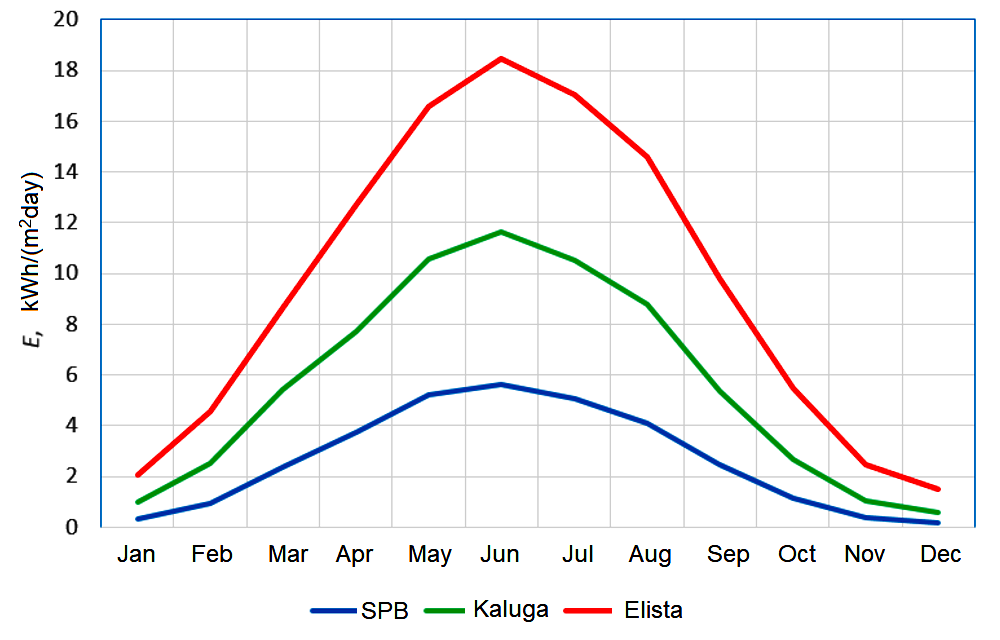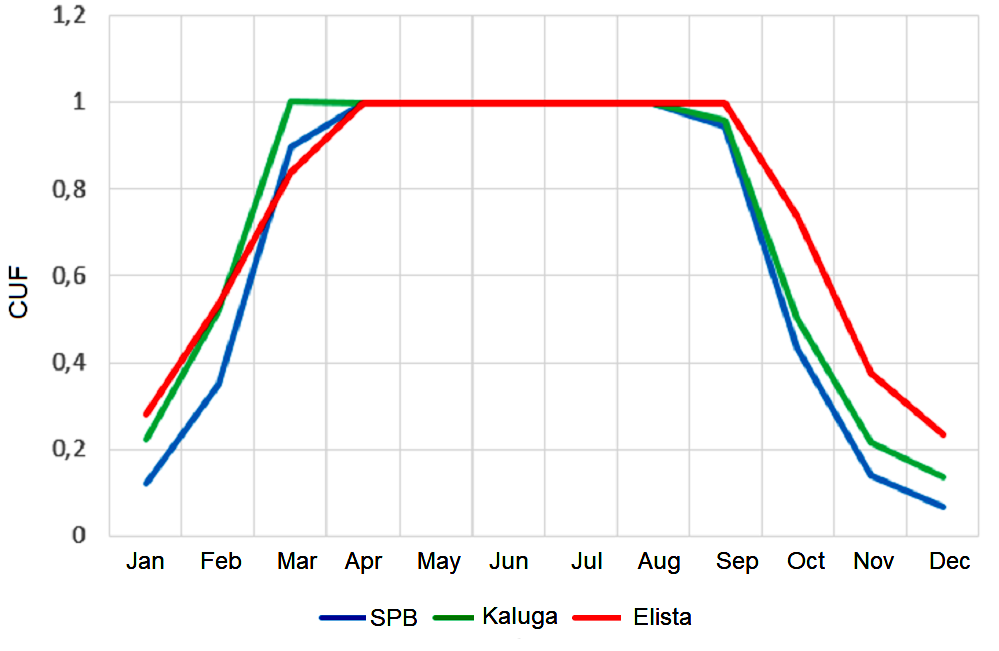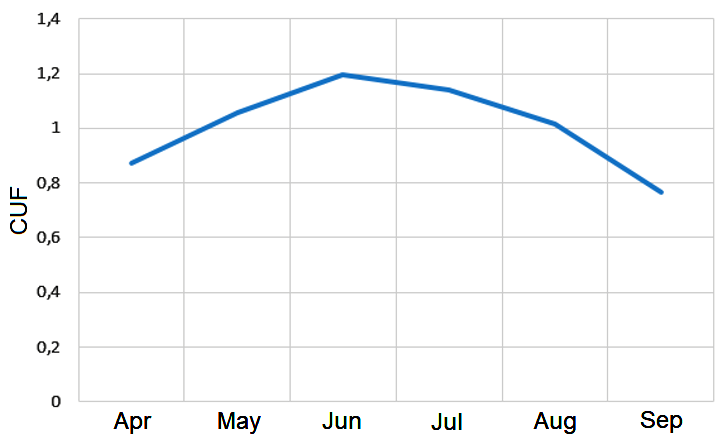Оценка характеристик солнечных тепловых электрических станций для климатических условий европейской части Российской Федерации
Оценка характеристик солнечных тепловых электрических станций для климатических условий европейской части Российской Федерации
Аннотация
Использование солнечного излучения в качестве энергетического источника становится всё более распространённым благодаря его экологической чистоте и доступности. Естественно, что применение солнечных энергосистем наиболее оправдано в тех регионах, где продолжительность солнечного сияния в течение года значительна. Однако для каждого конкретного региона обоснование целесообразности использования, например, солнечных тепловых электрических станций, является важной технико-экономической задачей. Этой проблеме применительно к европейской части Российской Федерации и посвящено исследование, описанное в данной статье.
Вначале доказывается перспективность разработки солнечных тепловых электрических станций башенного типа и рассматриваются их достоинства перед солнечными электростанциями фотоэлектрического типа.
Далее описывается методика определения энергетических показателей солнечных тепловых электрических станций с использованием доступных в сети Интернет статистических метеорологических баз данных по солнечной иррадиации и применением универсального, свободно распространяемого языка программирования Python. Также в описываемом исследовании были использованы и базы данных по характеристикам существующих солнечных тепловых электростанций (СТЭС) башенного типа.
Приведены результаты расчёта энергетических характеристик СТЭС для климатических условий трёх городов европейской части РФ. В процессе анализа и обсуждения результатов сделаны выводы по целесообразности строительства СТЭС для климатических условий европейской части РФ.
Использование изложенных в статье принципов исследований СТЭС даёт проектировщику удобный инструмент не только для получения характеристик рассматриваемых типов электростанций, но и для технико-экономического обоснования их применения в заданном регионе.
1. Introduction
The development of technologies for the production of electric energy based on the use of non-traditional and renewable sources of electric energy is important due to the limited and exhaustible resource base of organic fuel, the likely passage of the peak of its production, a sharp increase in the cost in world and regional markets .
According to the principles described in the Energy Strategy of Russia for the period up to 2035
, the main content of its third stage (2026-2035) "will be a gradual transition to a new generation of energy, based on the highly efficient use of traditional energy resources and new hydrocarbon and non-hydrocarbon energy sources," and after the implementation of this stage, it is planned to further reduce hydrocarbons in the structure of the fuel and energy complex of Russia. Thus, the percentage of renewable energy sources should steadily increase over time. The Power Machines company, as the largest manufacturer of heat and power equipment in the Russian Federation, can find a place for its traditional products – steam turbine plants, during the construction of new electric generation facilities based on renewable energy sources, for example, solar radiation energy.Projects of tower-type solar thermal power plants (STPP) are known and implemented . Unlike more common photovoltaic stations , the traditional cycle of a steam turbine power plant with a heat source – solar radiation is implemented here. Sunlight is concentrated using heliostat mirrors, on a heat exchanger placed on top of the tower. There, the intermediate coolant (mixture of molten salts) is heated to a high temperature. This intermediate coolant is used to produce working fluid – water vapor in the cycle of a steam turbine plant (STP). STPP can work at night due to the supply of thermal energy in storage thermal tanks with molten salt. This is a key advantage of STPP compared to solar power plants of the photovoltaic type, the results of which are given by the authors in the article .
2. Research methods and principles
The most important characteristics of STPP are: the area of reflecting mirrors-heliostats, the area of the STPP site occupied by them, the estimated Capacity Utilization Factor (CUF). These parameters are largely determined by the geographical and climatic characteristics of the STPP location. Analysis of the map of solar irradiation of the Russian regions made it possible to identify three characteristic areas in the European part of the Russian Federation. Low irradiation area (Arkhangelsk, St. Petersburg) – E1 ≈ 3.3 kWh/(m2day); an area with an average level of irradiation (Kaluga, Nizhny Novgorod, Kazan, Chelyabinsk) – E2 ≈ 3.5 kWh/(m2day) and an area with a high level of irradiation (Taganrog, Krasnodar, Astrakhan, Elista) – E3 ≈ 4.5 kWh/(m2day).
The analysis of statistical meteorological data for these regions and the characteristics of the implemented foreign STPP projects will make it possible to assess the characteristics of STPP for the climatic conditions of the European part of the Russian Federation.
The work is based on the use of statistical meteorological data presented in the public domain on the NASA Prediction Of Worldwide Energy Resources website .
Parsing of this data from the site into Excel files and their further processing was carried out using the widespread Python programming language .
When analyzing the characteristics of tower-type solar thermal power plants, the data presented on the Solar PACES website, a project of the International Energy Agency, were used .
3. Main results
Currently, about three dozen tower-type STPP are known in the world. Most of them are in the United States, Spain and China. The characteristics of some implemented tower-type STPP projects are given in Table 1.
Table 1 - Characteristics of completed STPP projects
Name, country | Power, MW | Occupied area, km2 | Area of heliostats, km2 | Heat energy accumulation, hours | Cost, million dollars |
Ivanpah Solar Power Facility, USA | 382 | 14.2 | 2.43 | n.a. | 2339 |
Khi Solar One, South Africa | 50 | 1.4 | 0.58 | 2 | 467 |
CEEC Hami CSP, China | 50 | 4.4 | 0.697 | 8 | 238 |
Atacama 1, Chile | 110 | 7 | 1.484 | 17.5 | 1400 |
Ashalim Plot B, Israel | 121 | 3.2 | 1.05 | n.a. | 854 |
Сrescent Dunes Solar Energy Progect, USA | 110 | 6.5 | 1.2 | 10 | 1032 |
Analysis of the data presented in Table 1 made it possible to obtain some characteristic specific characteristics of STPP: specific occupied area of the power plant - F = 0.026-0.037 km2/MW without thermal energy storage; F = 0.06-0.09 km2/MW with thermal energy accumulators providing STPP operation at night for 8-10 hours. Specific cost of construction of STPP C = 4700-13000 $/kW.
The CEEC Hami CSP project, which has been in operation since 2019, was selected to assess the efficiency of converting solar energy into electrical energy. According to the data , steam turbine plant of this STPP has an efficiency of 44%. Therefore, the thermal power of the steam generator will be about 114 MW. The average solar irradiation for the location of the STPP (Xinjiang Uygur region of China) is about 5.5 kWh/m2day. These data made it possible to estimate the overall efficiency of the heliostats-solar tower-energy storage-steam generator system of 72-75%.
To assess the STPP characteristics for the climatic conditions of the European part of the Russian Federation, an analysis of meteorological data was carried out for St. Petersburg, Kaluga and Elista. Data were obtained using the service using parsing and averaged over months over a 10-year time interval (from 2011 to 2021) taking into account actual meteorological conditions using a Python program using a special mean function that calculates the average value of the list . The distribution of the average value of solar irradiation E, kWh/( m2day) by months is shown in Figure 1.

Figure 1 - Annual distribution of solar irradiation for climatic conditions of three cities
Table 2 - STPP characteristics for climatic conditions of the European part of the Russian
Parameter | St. Petersburg | Kaluga | Elista |
STP power, MW | 50 | ||
Steam generator power, MW | 125 | ||
Required solar radiation power, MW· h/day | 4000 | ||
Required area of heliostats mirrors, km2 | 1.52 | 1.32 | 1.04 |
Area occupied by STPP, km2 | ~9 | ~8 | ~6.2 |
Given the uneven distribution of solar irradiation by seasons, the average CUF by month will also be different. Data illustrated in Figure 2.

Figure 2 - Distribution of CUF STPP by months of the year
4. Discussion
The average CUF STPP for climatic and meteorological conditions of St. Petersburg was 0.66; for Kaluga – 0.72; for Elista – 0.75. For all cases considered, a theoretical IC close to unity will be observed for 5 months of the year (from April to August). However, it should be noted that in the summer months there will be an excess of solar radiation. With the area of heliostat mirrors determined by the average annual irradiation, in summer the solar radiation flux will be 1.6-2.0 times higher than necessary. This, with sufficient capacity of energy storage tanks, is guaranteed to provide STP energy in the dark. In the winter months, a strong lack of solar radiation will be observed for all three locations. In winter and autumn, for the geographical and climatic conditions of St. Petersburg and Kaluga, the operation of STPP is likely to be impossible in the daytime without an additional source of energy (for example, burning natural gas, which is practiced in some STPP projects).
A feature of tower-type STPP is that ordinary thermal power equipment of TPPs using organic fuel is used to generate electric energy. Steam generation in the heat exchanger by heating with molten salt can be duplicated by a conventional boiler plant operating, for example, on natural gas. In winter, such a thermal power plant can operate on organic fuel, and in summer, during the period of maximum solar irradiation, on the energy of solar radiation. In this case, the required area of heliostat mirrors can be selected based not on the average annual value of solar irradiation, and on the average value of the hottest months of the year. This will make STPP much more compact and cheaper. So, for the climatic conditions of Elista, for the period from April to September, the average value of solar irradiation is E = 5.76 kWh/(m2day). To ensure round-the-clock operation of the STPP, the area of heliostat mirrors of the order F = 0.70 km2 will be required.
For a more detailed presentation of the operating conditions of the solar power plant, using a Python program, the distribution of CUF STPP for the indicated months was obtained, shown in Figure 3.

Figure 3 - Distribution of СUF for STPP operating in the hot season
5. Conclusion
Based on the results of the study, the following main conclusions can be drawn:
1. Averaged characteristics of solar irradiation were determined for three characteristic regions of the European part of the Russian Federation - St. Petersburg, Kaluga, Elista.
2. The characteristics of tower-type STES with a capacity of 50 MW were determined for three characteristic regions of the European part of the Russian Federation:
– specific capital costs for the construction of power plants significantly exceed the costs for the construction of traditional power generating capacities S = 4700-13000 $/kW;
– the required area of heliostats mirrors will be from 1 to 1.5 km2;
– TPP site area will be from 6 to 9 km2;
– the average CUF was determined during the year and its distribution by months.
3. Given the current level of prices and the availability of organic and nuclear fuel, the construction of a STPP for the climatic conditions of the European part of the Russian Federation seems inappropriate.
4. It is possible to build a combined thermal power plant (organic fuel/solar radiation) for the southern regions of the Russian Federation. In this case, CUF will be close to one throughout the calendar year.
5. Taking into account that the products of the Power Machines company are widely represented on world markets, it is possible to expand the company's portfolio of orders through the construction of power plants in the countries of Central Asia, the Middle East, Africa, which are characterized by a greater amount of solar irradiation compared to the territory of the Russian Federation.
The results of this work can be used in the development, construction and operation of a tower-type combined TPP/STPP demonstrator in one of the southern regions of the Russian Federation.
Experimental data obtained during the operation of such a TPP can be used in the future in the construction of STPPs in the countries of Central Asia, the Middle East, and Africa.
